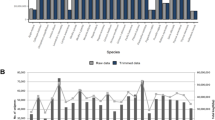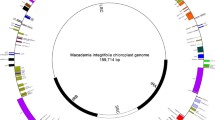Abstract
High-throughput sequencing is fundamentally altering traditional phylogenetic classifications. While the Angiosperm Phylogeny Group (APG) III system based on chloroplast sequences has opened up a new era of angiosperm molecular classification, the use of nuclear genome sequences is more helpful for a precise phylogenetic analysis. However, such attempts have so far been applied to only a very limited number of angiosperm plant families. We constructed a phylogenetic tree of 25 plant species with well assembled genome sequences representing 19 angiosperm families and one gymnosperm family (as out group) using 390 orthologous genes. Our results strongly support the moving of Rhamnaceae to order Rosales from Rhamnales, abolishing Rhamnales, and establishing the new order Malpighiales in the APG III system. Our data also showed some characteristics inconsistent with the APG III classification and provided a reinterpretation of phylogeny for some of the families involved. We propose that Malpighiales should be placed in Malvids, not Fabids. The four monocot species representing four families were clustered together, indicating that monocot is a natural taxon. In summary, our results support almost all the APGIII treatments of the orders involved in this study and provided some surprising reinterpretations at levels beyond order.

Similar content being viewed by others
References
Al-Dous EK, George B, Al-Mahmoud ME et al (2011) De novo genome sequencing and comparative genomics of date palm (Phoenix dactylifera). Nat Biotechnol 29:521–527. doi:10.1038/nbt.1860
Amborella Genome Project (2013) The Amborella genome and the evolution of flowering plants. Science 342:1241089. doi:10.1126/science.1241089
Argout X, Salse J, Aury JM et al (2011) The genome of Theobroma cacao. Nat Genet 43:101–108. doi:10.1038/ng.736
Chen YL, Schirarend C (2007) Rhamnaceae. In: Wu ZY, Peter RH, Hong DY (eds) Flora of China, vol 12. Science Press, Beijing, pp 115–168
Cronquist A (1988) The evolution and classification of flowering plants, 2nd edn. New York Botanical Garden, Bronx
Darriba D, Taboada GL, Doallo R (2012) Posada D jModelTest 2: more models, new heuristics and parallel computing. Nat Methods 9:772. doi:10.1038/nmeth.2109
D’Hont A, Denoeud F, Aury JM et al (2012) The banana (Musa acuminata) genome and the evolution of monocotyledonous plants. Nature 488:213–217. doi:10.1038/nature11241
He N, Zhang C, Qi X et al (2013) Draft genome sequence of the mulberry tree Morus notabilis. Nat Commun. doi:10.1038/ncomms3445
Huang S, Li R, Zhang Z et al (2009) The genome of the cucumber, Cucumis sativus L. Nat Genet 41:1275–1281. doi:10.1038/ng.475
Initiative The Arabidopsis Genome (2000) Analysis of the genome sequence of the flowering plant Arabidopsis thaliana. Nature 408:796–815. doi:10.1038/35048692
International Rice Genome Sequencing Project (2005) The map-based sequence of the rice genome. Nature 436:793–800. doi:10.1038/nature03895
Jaillon O, Aury JM, Noel B et al (2007) The grapevine genome sequence suggests ancestral hexaploidization in major angiosperm phyla. Nature 449:463–467. doi:10.1038/nature06148
Li L, Stoeckert CJ, Roos DS (2003) OrthoMCL: identification of ortholog groups for eukaryotic genomes. Genome Res 13:2178–2189. doi:10.1101/gr.1224503
Liu MJ, Zhao J, Cai QL et al (2014) The complex jujube genome provides insights into fruit tree biology. Nat Commun 5:5315. doi:10.1038/ncomms6315
Ming R, Hou S, Feng Y et al (2008) The draft genome of the transgenic tropical fruit tree papaya (Carica papaya Linnaeus). Nature 452:991–996. doi:10.1038/nature06856
Nystedt B, Street NR, Wetterbom A et al (2013) The Norway spruce genome sequence and conifer genome evolution. Nature 497:579–584. doi:10.1038/nature12211
Peng Z, Lu Y, Li L et al (2013) The draft genome of the fast-growing non-timber forest species moso bamboo (Phyllostachys heterocycla). Nat Genet 45:456–461. doi:10.1038/ng.2569
Sato S, Hirakawa H, Isobe S et al (2011) Sequence analysis of the genome of an oil-bearing tree, Jatropha curcas L. DNA Res 18:65–76. doi:10.1093/dnares/dsq030
Schmutz J, Cannon SB, Schlueter J et al (2010) Genome sequence of the palaeopolyploid soybean. Nature 463:178–183. doi:10.1038/nature08670
Shulaev V, Sargent DJ, Crowhurst RN et al (2011) The genome of woodland strawberry (Fragaria vesca). Nat Genet 43:109–116. doi:10.1038/ng.740
The Angiosperm Phylogeny Group (2009) An update of the Angiosperm Phylogeny Group classification for the orders and families of flowering plants: APG III. Bot J Linn Soc 161:105–121
The International Peach Genome Initiative (2013) The high-quality draft genome of peach (Prunus persica) identifies unique patterns of genetic diversity, domestication and genome evolution. Nat Genet 45:487–494. doi:10.1038/ng.2586
The Potato Genome Sequencing Consortium (2011) Genome sequence and analysis of the tuber crop potato. Nature 475:189–195. doi:10.1038/nature10158
Tuskan GA, Difazio S, Jansson S et al (2006) The genome of black cottonwood, Populus trichocarpa (Torr. & Gray). Science 313:1596–1604. doi:10.1126/science.1128691
Velasco R, Zharkikh A, Affourtit J et al (2010) The genome of the domesticated apple (Malus × domestica Borkh.). Nat Genet 42:833–839. doi:10.1038/ng.654
Wang K, Wang Z, Li F et al (2012a) The draft genome of a diploid cotton Gossypium raimondii. Nat Genet 44:1098–1103. doi:10.1038/ng.2371
Wang Z, Hobson N, Galindo L et al (2012b) The genome of flax (Linum usitatissimum) assembled de novo from short shotgun sequence reads. Pl J 72:461–473. doi:10.1111/j.1365-313X.2012.05093.x
Wang Y, Fan G, Liu Y et al (2013) The sacred lotus genome provides insights into the evolution of flowering plants. Pl J 76:557–567. doi:10.1111/tpj.12313
Wu J, Wang Z, Shi Z et al (2013) The genome of the pear (Pyrus bretschneideri Rehd.). Genome Res 23:396–408. doi:10.1101/gr.144311.112
Xu Q, Chen LL, Ruan X et al (2013) The draft genome of sweet orange (Citrus sinensis). Nat Genet 45:59–66. doi:10.1038/ng.2472
Zhang SD, Soltis DE, Yang Y et al (2011) Multi-gene analysis provides a well-supported phylogeny of rosales. Molec Phylogen Evol 60:21–28. doi:10.1016/j.ympev.2011.04.008
Zhang Q, Chen W, Sun L et al (2012) The genome of Prunus mume. Nat Commun 3:1318. doi:10.1038/ncomms2290
Acknowledgements
This work was supported by grants from the National Science and Technology Support Plan of China (2013BAD14B03), The Giant Plan of Hebei, China, and The Top Talent Project of Hebei, China and Agricultural University of Hebei Foundation for Leaders of Disciplines in Science Technology. We thank Dr. Peter Gorsuch, Dr. Laurie Goodman as well as MSC Scientific Editing and American Journal Experts for their kind assistance with manuscript revisions.
Author information
Authors and Affiliations
Corresponding author
Ethics declarations
Conflict of interest
The author declares that he has no conflict of interest.
Additional information
Handling editor: Pablo Vargas.
Mengjun Liu and Jin Zhao have contributed equally to this work.
Electronic supplementary material
Below is the link to the electronic supplementary material.
606_2016_1380_MOESM2_ESM.pdf
Online Resource 2 Phylogenetic relationships among 21 plant species (only one single Rosaceae species is used) representing 19 angiosperm families and one gymnosperm family. The phylogenetic tree was constructed using 390 orthologous genes by the maximum likelihood method on 4-fold degenerate sites.
Information on Electronic Supplementary Material
Information on Electronic Supplementary Material
Online Resource 1. Sequence information of the 390 orthologous genes from 25 plant species used in this study.
Online Resource 2. Phylogenetic relationships among 21 plant species (only one single Rosaceae species is used) representing 19 angiosperm families and one gymnosperm family. The phylogenetic tree was constructed using 390 orthologous genes by the maximum likelihood method on fourfold degenerate sites.
Rights and permissions
About this article
Cite this article
Liu, M., Zhao, J., Wang, J. et al. Phylogenetic analysis of 25 plant species representing 19 angiosperm families and one gymnosperm family based on 390 orthologous genes. Plant Syst Evol 303, 413–417 (2017). https://doi.org/10.1007/s00606-016-1380-9
Received:
Accepted:
Published:
Issue Date:
DOI: https://doi.org/10.1007/s00606-016-1380-9




